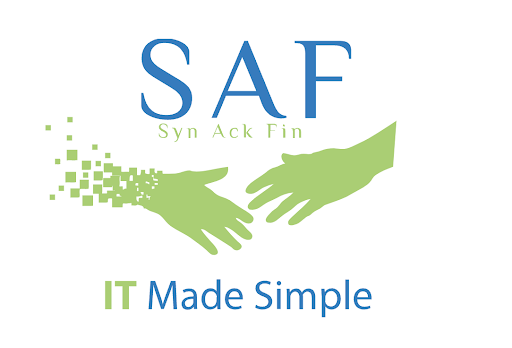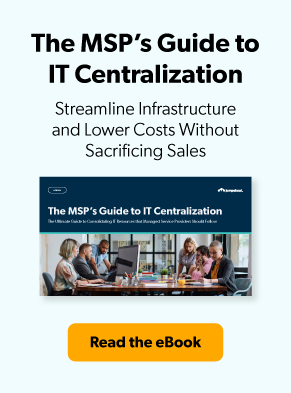Multi-tenancy refers to a software architectural arrangement that enables multiple users, or “tenants” to share resources in a single environment. Each tenant’s operations are within their isolated virtual space while the underlying infrastructure supports them all.
Multi-tenancy has existed in various forms over the years. For example, in the 1960s, companies used time-sharing to rent processing and work times on mainframes. Similarly, during the 1990s, application service providers (ASPs) emerged, hosting multiple applications for customers, often on different machines.
The software has undergone several transformations over time, and today, managed services providers (MSPs) leverage cloud environments to serve multiple clients in remote locations, reduce costs, and become more flexible.
In this article, we’ll explore how multi-tenancy has become indispensable for MSPs and how the JumpCloud Multi-Tenant Platform (MTP) helps MSPs improve their operations and drive business growth.
Managed Services Providers Before MTP
There was a time when most organizations’ infrastructures were on-prem and it was standard for MSPs to travel miles to perform general maintenance and fix problems whenever they arose. This model, known as the break-fix model, was problematic for several reasons.
- The hours spent on the road could have been put to better use.
- MSPs could only serve clients within a physically accessible range. This neither makes for good business for the MSP nor does it make for timely service for the client.
Thanks to the rise of cloud computing and Software-as-a-Service (SaaS), multi-tenancy environments now make it possible for MSPs to deliver their services to a large number of clients remotely, and through a single pane of glass.
What Is JumpCloud’s Multi-Tenant Portal?
JumpCloud’s Multi-Tenant Portal is a browser-based console that grants MSPs a comprehensive view of top-level data and centralized control over each of their clients. It also enables them to securely launch full management sessions for each organization they administer.
Features
JumpCloud’s Multi-Tenant Portal allows for:
Centralized Management for All Clients
From a single platform, MSPs provide their clients with identity and access control across their resources, enforce system security settings at scale, implement multi-factor authentication (MFA), and manage networks through RADIUS. They are also capable of providing single sign-on (SSO) applications through SAML and cloud LDAP.
Custom Branding for Each Client
While MSP technicians are trained up on the JumpCloud platform, and thus recognize the look and feel of the various product screens, clients may not know (or even care, quite frankly) what technology powers their interactions with their devices, applications, and other resources. Thus, it can help encourage adoption and familiarity if an MSP can brand the client-facing aspects of the product to integrate the experience within the look and feel of their clients’ company.
JumpCloud supports this functionality, allowing MSPs to upload logos and customize messages throughout the various screens and widgets that their clients interact with directly.
Flexible Billing Options
MSPs are responsible for paying for organizations within their MTP. As clients’ needs typically differ, MSPs can choose different pricing plans for each organization within the MTP. JumpCloud supports credit card billings within the MTP, however, MSPs who prefer a different payment method can email [email protected]
Automated Client Onboarding and Offboarding
Within JumpCloud MTP, MSPs can connect users to clients’ resources through their email accounts to onboard them. This saves admins from the nightmarish experience of having to manually connect each user, in each client organization, to their work devices or resources.
In a similar fashion, MSPs can revoke a user’s access to the client’s resources within JumpCloud by simply de-provisioning them from the client’s users tab.
Granular Role-Based Access Control
MSPs are able to set different access levels for themselves and users within their client organizations. MSP leaders can define and attach privileges to roles and grant these roles to other admins or team members. This control extends to the child organizations within the MTP as MSPs can define access levels for individual users in each client organization.
Benefits of Using JumpCloud’s Multi-Tenant Portal
MSPs that leverage JumpCloud’s MTP enjoy:
Enhanced Efficiency and Productivity
MSPs score great efficiency points when they are able to manage their clients from a unified console. With JumpCloud MTP, they can easily switch between client organizations, view top-level data, and perform administrative tasks seamlessly.
Also, it helps MSPs do more in less time. For example, they can push security updates and configurations simultaneously and enforce best practices uniformly across their client base.
Improved Client Experience and Satisfaction
With JumpCloud’s MTP, MSPs can offer their clients excellent experiences across their resources.
First, MSPs can offer a unified login experience for their clients. This eliminates the need for users to have multiple credentials and makes single sign-on easier to implement.
Second, with the centralized dashboard, MSPs can quickly identify and resolve any issues, reducing downtime and minimizing disruptions to their client’s activities.
Reduced Overhead Costs
MSPs greatly enjoy the bundle of tools made available within JumpCloud MTP. Not only do they have to invest in fewer hardware installations, but they can also save up on licensing costs of disparate tools.
Increased Revenue Potential
MSPs that leverage JumpCloud MTP are in a prime position to increase their revenue thanks to the efficiency it delivers. First, it helps them serve more clients without compromising on service quality. Also, users and clients that experience the convenience that it provides are more likely to refer other customers to their MSP.
Last, through the JumpCloud partnership program, MSPs can upsell and cross-sell additional services, expanding their revenue streams.
MSP Success Stories with JumpCloud
Several MSPs with different needs have enjoyed the benefits that the MTP confers on MSP operations and their client’s experiences.
Let’s run through a few use cases below.
MSPs Group 1: Cutting Overhead Costs and Increasing Productivity
We begin with Altitude Integrations, a Colorado-based MSP with over 200 clients around the country. With its clients relying on cloud-based services, Altitude Integrations needed a secure system that creates efficiencies for its clients and reduces costs. And it didn’t need to look farther than the JumpCloud directory platform.

After crunching the numbers, company leadership realized that — for an organization with a single office, 200 employees, heterogeneous devices, and 50% remote workforce — JumpCloud cost only one-fifth of Active Directory and Okta’s costs.
Their clients also enjoyed a whopping 75% decrease in password reset tickets because they could now provide seamless user access regardless of users’ location.
Altitude Integration enjoys an ever-expanding client base with increasing geographical reach. JumpCloud’s MTP provides an excellent platform for MSPs to support them all.
Some of these organizations aren’t going to go back to a single office. They’re going to stay fragmented, but we’re set up to be able to help them.
Brett Ramberg, Co-CEO at Altitude Integrations
This is similar to the experience of Brian Coleman, founder of Matchstick Birmingham, who said: “If it weren’t for JumpCloud, my dream of making this small company a success would never have happened.”
Located in Alabama, Matchstick Birmingham clients often needed to implement identity management alongside device management. With several of them needing to implement these for the first time, they could easily have been dissuaded due to the high infrastructural costs that could have been required to achieve this.

Brian and his team, however, have a better solution up their sleeves. Get a device-and-environment-agnostic vendor, couple it with other solutions as required by different clients, and market it as a unique product.
With this, Matchstick Birmingham has been able to provide a lightweight but powerful solution to help their clients avoid the huge upfront and continued costs of managing on-prem servers and Windows licensing.
MSP Group 2: Improving Client Satisfaction
MSPs all over the country have enjoyed great success in delivering an exceptional client experience thanks to JumpCloud’s MTP.
Take Syn Ack Fin (SAF) for example. Located in Denver Colorado, SAF has been around the block since 2001 and has been a one-stop shop for organizations’ IT needs.

Its clients have often had problems such as zero password controls, non-existent password databases, inconsistent user account naming, etc. SAF, having experienced firsthand the unwieldiness and steep learning curve of Active Directory, was on the lookout for a better solution for its clients.
SAF got wind of JumpCloud and started using it internally. Its remarkable ability to support users irrespective of what device they use was a game-changer; SAF began leveraging JumpCloud for clients as well. Pretty soon, JumpCloud MTP became a standard feature of SAF offerings and their clients have enjoyed consistent service delivery thanks to JumpCloud.
Similarly, Macktez, a New York-based MSP, has leveraged JumpCloud MTP in creating a gapless experience for their clients who’ve had to adapt to remote work and shifting resources to the cloud.

When designing a consistent user experience, you want credentials that work for everything. Reilly Scull, CTO of Macktez, decided to use JumpCloud MTP and it’s been an easier and more secure way to support their many clients.
Now, Macktez’s clients have enjoyed utilizing an open, scalable, and future-proofed infrastructure that caters to their evolving needs.
Leverage the Power of a Multi-Tenant Cloud-Based System
Are you an MSP who is on the lookout for a centralized, efficient, and secure solution for managing your clients’ IT needs?
Then you should absolutely sign up to enjoy JumpCloud’s Multi-Tenant cloud-based system today. With it, you can reduce overhead costs while delivering an exceptional client experience from anywhere in the world. Also, consider being a JumpCloud Partner.
JumpCloud MSP Partners receive discounts, support, and co-marketing materials to help expand their client bases. Join today and unlock the full potential of efficient and secure client management.





